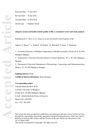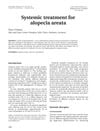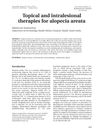TLDR Topical corticosteroids are the preferred first treatment for children with Alopecia Areata.
The review article assessed treatment modalities for Alopecia Areata (AA), an autoimmune form of hair loss. It concluded that topical corticosteroids, due to their low risk of adverse effects and ease of use, were commonly used as the first line of treatment for children with AA. In more severe cases, systemic therapies were employed, which primarily functioned by modulating or suppressing the immune system. All treatments were considered off-label and aimed to stimulate hair growth rather than cure the disease, as they could not alter its progression. The review included studies from September 2007 to May 2021, focusing on English-language publications.
21 citations
,
December 2017 in “The journal of investigative dermatology. Symposium proceedings/The Journal of investigative dermatology symposium proceedings” Simvastatin/ezetimibe may help treat new cases of alopecia areata but not long-term cases.
13 citations
,
January 2017 in “Annals of dermatology/Annals of Dermatology” Simvastatin/ezetimibe may help some patients with severe alopecia areata regrow hair.
 128 citations
,
February 2016 in “British Journal of Dermatology”
128 citations
,
February 2016 in “British Journal of Dermatology” Alopecia areata significantly lowers the quality of life, especially in emotional and mental health aspects.
 218 citations
,
April 2012 in “British Journal of Dermatology”
218 citations
,
April 2012 in “British Journal of Dermatology” Guidelines suggest various treatments for alopecia areata, but leaving it untreated is also an option as 80% cases may recover on their own.
 16 citations
,
May 2011 in “Dermatologic therapy”
16 citations
,
May 2011 in “Dermatologic therapy” Effective treatments for severe alopecia areata are still lacking.
 36 citations
,
May 2011 in “Dermatologic therapy”
36 citations
,
May 2011 in “Dermatologic therapy” No treatments fully cure or prevent alopecia areata; some help but have side effects or need more research.




